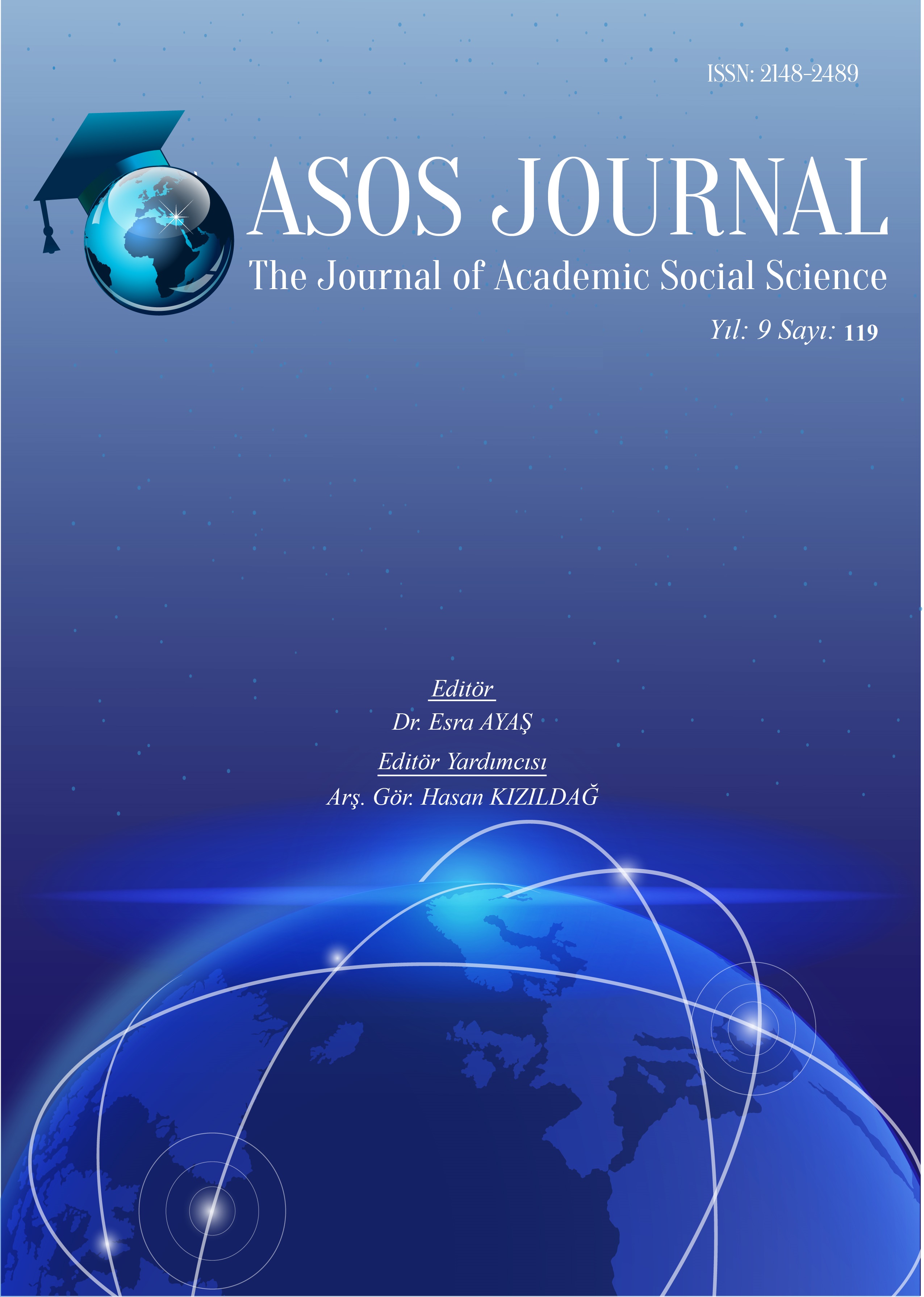Author :
Abstract
Caryl Churchill İngiltere’nin önde gelen yetenekli, çağdaş oyun yazarlarından biridir. 1960’lardan beri, yazar, politik meselelerden, cinsiyet sorunlarına ve çevresel problemlere kadar çeşitli konularda otuz adet oyun yayımlamıştır. Churchill’in oyunlarında bahsedilen sosyal sorunlar arasında çevreyle ilgili endişeler ve doğal felaketler göze çarpmaktadır çünkü yazar eserlerinde doğanın yok edilmesine karşı önemli bir bilinç göstermektedir. Bu bağlamda Churchill’in ekolojik oyunlarında Antroposen ve Kapitalosen kavramlarıyla ilgili temalar öne çıkmaktadır. Kısaca insan etkinliklerinin dünya üzerinde gözlemlenen etkisi olarak tanımlanan Antroposen kavramı 2000 yılında ortaya atılmış ve akademisyenler tarafından pek çok kez yeniden tanımlanmıştır. Bu tanımlamalar arasında en çok dikkat çeken Kapitalosen kavramı olmuştur ki bu terim, söz konusu dönemin kapitalizmin doğaya ve topluma yarattığı yıkıcı etkiler tarafından şekillendirildiğini ifade etmektedir. Bu makalenin temel amacı Churchill’in Not not not not not enough oxygen ve Far Away oyunlarında Antroposen ve Kapitalosen tasvirlerini ortaya koyarak, yazarın oyunlarında bu tasvirlerin hangi sebeplerle ve nasıl sunulduğunu açığa çıkarmaktır. Bu yüzden araştırma, Churchill’in tiyatrosunun bir Antroposen tiyatrosu olduğunu gözler önüne sermekte ve yazarın İngiliz toplumu ve kamuoyunda çevre bilinci oluşturmak amacıyla yönelttiği kapitalizm eleştirisini gün yüzüne çıkarmaktadır.
Keywords
Abstract
Caryl Churchill is one of Britain’s most prominent and talented contemporary playwrights. Since the 1960s, the author has published thirty plays dealing with a wide variety of subjects from political matters to gender issues and ecological problems. Amongst the many issues and social problems of Churchill’s dramatic oeuvre, natural concerns and environmental catastrophes stand out as the dramatist displays significant awareness towards issues concerning the destruction of nature. To that end, particular themes related to the Anthropocene and Capitalocene come forward in Churchill’s ecological plays. Briefly defined as the era of observable human impact on Earth, the Anthropocene was coined in 2000 and reformulated by scholars various times. The most notable reinterpretation of the Anthropocene resulted in the coining of the Capitalocene which argues that this epoch was largely shaped by the detrimental effects of capitalism on the human society and naturally, on Earth as a whole. This article’s main purpose is to expose specific depictions of the Capitalocene in Churchill’s Not not not not not enough oxygen and Far Away to reveal why and how these depictions are presented in the author’s plays. Therefore, the study demonstrates Churchill’s theatre as a theatre of the Anthropocene and reveals the dramatist’s critique of capitalism in order to raise awareness towards environmental issues in the British society and public opinion.
Keywords
- Altvater, E., Crist, E. C., Haraway, D. J., Hartley, D., Parenti, C., and McBrien, J. (2016). Anthropocene or Capitalocene?: Nature, history, and the crisis of capitalism. J. W. Moore (Ed.). PM Press.
- Aston, E., and Diamond, E. (2009). The Cambridge Companion to Caryl Churchill. Cambridge University Press.
- Biber Vangölü, Y. (2017). Revisiting the Dystopian Visions in Not Not Not Not Not Enough Oxygen by Caryl Churchill. Hacettepe Üniversitesi Edebiyat Fakültesi Dergisi, 34(1). 195-203.
- Chakrabarty, D. (2009). The climate of history: Four theses. Critical Inquiry, 35(2), 197-222. doi:10.1086/596640
- Churchill, Caryl.(2008). Plays Four. Nick Hern Books..
- .......................... (2016). Caryl Churchill: Shorts. Nick Hern Books..
- Davies, J. (2016). The Birth of the Anthropocene. University of California Press.
- Ghaffar Salem, H. A. (2021). Science fiction on stage: Dystopia in Caryl Churchill’s Far Away. European Journal of English Language and Literature Studies, 9(2), 33-39.
- Grear, A. (2017). Anthropocene, Capitalocene, Chthulucene’: Re-encountering Environmental Law and its ‘Subject’ with Haraway and New Materialism. In Environmental Law and Governance for the Anthropocene (pp. 77-96). Oxford: Hart Publishing.
- Hamilton, C., Gemenne, F., & Bonneuil, C. (2015). The Anthropocene and the global environmental crisis: Rethinking modernity in a new epoch. Routledge.
- Lewis, S. L., and Maslin, M. A. (2018). The Human Planet: How we created the Anthropocene. Penguin UK.
- McBrien, J. (2016). Accumulating Extinction Planetary Catastrophism in the Necrocene. In J. W. Moore (Ed.), Anthropocene or Capitalocene?: Nature, history and the crisis of capitalism (pp. 116-138). PM Press.
- Moore, J. W. (2015). Capitalism in the web of life: Ecology and the accumulation of capital. Verso Books.
- Rabillard, S. (2009). On Caryl Churchill’s ecological drama: Right to poison the wasps? The Cambridge Companion to Caryl Churchill, 88104. https://doi.org/10.1017/ccol9780521493222.006
- Ruddiman, W. F. (2003). The anthropogenic greenhouse era began thousands of years ago. Climatic Change, 61(3), 261-293. doi:10.1023/b:clim.0000004577.17928.fa
- Savilonis, M. (2016). “She was always sad”: Remembering mother in Caryl Churchill’s not enough oxygen and a number. Theatre History Studies, 35(1), 233253. https://doi.org/10.1353/ths.2016.0012
- Schwägerl, C. (2014). The Anthropocene: The human era and how it shapes our planet. Synergetic Press.
- Water scarcity | International decade for action 'Water for life' 2005-2015. (2015). United Nations, Department of Economics and Social Affairs. https://www.un.org/waterforlifedecade/scarcity.shtml
- Watkins, B. (2001). Spinning into butter, and: Far away, and: Credible witness, and: The bogus woman, and: The mother (review). Theatre Journal, 53(3), 481484. https://doi.org/10.1353/tj.2001.0093
- Zalasiewicz, J., Crutzen, P., & Steffen, W. (2012). The Anthropocene. The geologic time scale, 2, 1033-40.
- Zalasiewicz, J., Waters, C. N., Williams, M., Barnosky, A. D., Cearreta, A., Crutzen, P., … Oreskes, N. (2014). When did the Anthropocene begin? A mid-twentieth century boundary level is stratigraphically optimal. Quaternary International, 383, 196-203. doi:10.1016/j.quaint.2014.11.045
